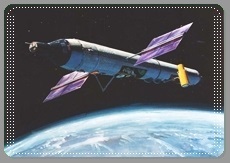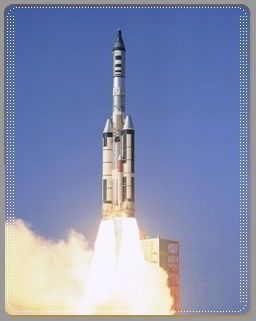
 | A declassified illustration of the MOL as it would have appeared in orbit. courtesy National Reconnaissance Organization |
The Manned Orbiting Laboratory (MOL) was a joint project of the U.S. Air Force (USAF) and the National Reconnaissance Office (NRO) to obtain high-resolution photographic imagery of America’s 1960's Cold War adversaries. Announced by Defense Secretary Robert S. McNamara in December 1963 and formally approved by President Lyndon B. Johnson in August 1965, the MOL Program envisioned a series of 60-foot-long space stations in low polar Earth orbit derived from the first stage of a Titan I rocket, occupied by 2-man crews for 30 days at a time, launching and returning to Earth aboard modified Gemini-B capsules. Externally similar to NASA’s Gemini spacecraft, the MOL version’s major modification was a hatch cut into the heat shield that allowed the astronauts to access the laboratory that was located behind the spacecraft without the need for a spacewalk. While MOL astronauts would carry out a variety of experiments, the primary payload intended to fly in the laboratory was a telescope with imaging systems for military reconnaissance, and a radar. The imaging system was codenamed Dorian and carried the Keyhole KH-10 designation. Its primary mirror was 72 inches in diameter, designed to provide high resolution images of targets of military interest. To reach their polar orbits, MOLs would launch from Vandenberg Air Force Base (AFB) in California, and construction of Space Launch Complex-6 (SLC-6) there was begun to accommodate the Titan-IIIM launch vehicle. The USAF selected 17 pilots in three groups for the MOL program. The only space launch in the MOL program occurred on Nov. 3, 1966, when a Titan-IIIC rocket took off from Cape Canaveral Air Force Station’s (CCAFS) Launch Complex 40. Atop the rocket was a MOL mockup, without the KH-10 imaging payload, and a Gemini-B capsule that was refurbished after it flew NASA’s uncrewed Gemini-2 suborbital mission in January 1965. This was the only time an American spacecraft intended for human spaceflight was reflown until the advent of the Space Shuttle. The major modification to the spacecraft was the addition of the hatch in the heat shield, which was tested successfully during the capsule’s reentry after a 33-minute suborbital flight. The Gemini-B capsule was recovered by the USS La Salle in the South Atlantic Ocean and returned to the Air Force for postflight inspection. It is currently on display at the Air Force Space & Missile Museum at CCAFS. The MOL mockup entered Earth orbit and released three satellites. It also carried a suite of 10 experiments called Manifold, ranging from cell growth studies to tests of new technologies. The experiments were designed to operate for 75 days, but the MOL stopped transmitting after 30 days, and decayed from orbit Jan. 9, 1967
 | The only operational launch of the MOL program, a Gemini-B capsule and a MOL mockup atop a Titan-IIIC rocket in 1966. courtesy NASA |
By 1969, the MOL program was several years behind schedule and significantly over budget, and other than the one test flight had not flown any actual hardware. Technology for military reconnaissance was advancing to the stage that the KH-10 proposed for MOL was becoming obsolete, as the USA had realized that unmanned satellites were as much efficient and with a lower cost. Following a review, the new administration of President Richard M. Nixon, faced with competing priorities for the federal budget, announced the cancellation of the MOL program on June 10, 1969. Some of the personnel involved as well as some of the hardware that was developed for it, made its way into other agencies and projects. For example, the Air Force had developed a flexible spacesuit required by the MOL astronauts to navigate through the narrow tunnel between the Gemini-B capsule and the laboratory – that technology was transferred to NASA for future spacesuit development. The waste management system designed for use by MOL astronauts was flown aboard Skylab. The MOL laboratory simulator and the special computer to operate it were also transferred to NASA. The technology developed for the acquisition and tracking system and the mission development simulator for the KH-10 imaging system found its way into NASA’s earth sensing program. After the cancellation of the MOL program, NASA also invited the younger (under 35) MOL astronauts to join its astronaut corps and eventually all of them went on to fly on the Space Shuttle in the 1980's. The nearly completed SLC-6 facility at Vandenberg AFB was converted to launch the Space Shuttle with payloads requiring a polar orbit. Although Space Shuttle Enterprise used SLC-6 for fit checks in 1985, the Challenger accident the following year caused the Air Force to cancel plans to use Space Shuttle to launch polar orbiting satellites, and the pad was mothballed. It was modified and used to launch small Athena rockets between 1995 and 1999, the first launches from the facility after 30 years of development and modifications. One more conversion begun in 1999 which modified SLC-6 to launch Delta-IV and Delta-IV Heavy rockets starting in 2006. Six surplus 72-inch mirrors from the cancelled KH-10 program were transferred to the Smithsonian Astrophysical Observatory for the Multiple-Mirror Telescope it built in association with the University of Arizona, located on Mount Hopkins, Arizona
Website Manager: G. Guichard, site 'Amateur Astronomy,' http://stars5.6te.net. Page Editor: G. Guichard. last edited: 6/14/2019. contact us at ggwebsites@outlook.com